
Hylaeosaurus is a herbivorous ankylosaurian dinosaur that lived about 136 million years ago, in the late Valanginian stage of the early Cretaceous period of England. It was found in the Grinstead Clay Formation.
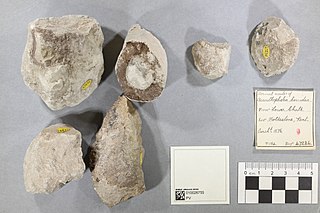
Acanthopholis is a genus of ankylosaurian dinosaur in the family Nodosauridae that lived during the Late Cretaceous Period of England. A single species, A. horrida, exists.
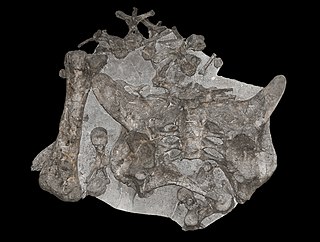
Dacentrurus, originally known as Omosaurus, is a genus of stegosaurian dinosaur from the Late Jurassic and perhaps Early Cretaceous of Europe.

Ornithocheirus is a pterosaur genus known from fragmentary fossil remains uncovered from sediments in the United Kingdom and possibly Morocco.

Anoplosaurus is an extinct genus of herbivorous nodosaurid dinosaur, from the late Albian-age Lower Cretaceous Cambridge Greensand of Cambridgeshire, England. It has in the past been classified with either the armored dinosaurs or the ornithopods, but current thought has been in agreement with the "armored dinosaur" interpretation, placing it in the Ankylosauria.

Aristosuchus is a genus of small coelurosaurian dinosaur whose name was derived from the Greek ἄριστος and σουχος. It shared many characteristics with birds.
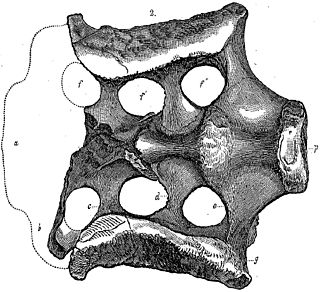
Atlantosaurus is a dubious genus of sauropod dinosaur. It contains a single species, Atlantosaurus montanus, from the upper Morrison Formation of Colorado, United States. Atlantosaurus was the first sauropod to be described during the infamous 19th century Bone Wars, during which scientific methodology suffered in favor of pursuit of academic acclaim.
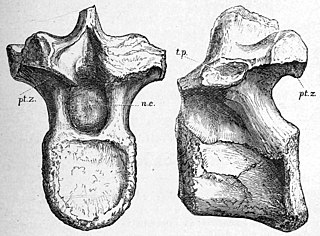
Syngonosaurus is an extinct genus of ornithopod dinosaur from the Early Cretaceous. It was an iguanodontian discovered in the Cambridge Greensand of England and was first described in 1879. The type species, S. macrocercus, was described by British paleontologist Harry Seeley in 1879 and it was later synonymised with Acanthopholis, but the genus was reinstated in a 2020 study, when Syngonosaurus and Eucercosaurus were reinterpreted as basal iguanodontians.

Eucercosaurus is the name given to a genus of ornithopod dinosaur from the Albian stage of the Early Cretaceous. It was an ornithopod discovered in the Cambridge Greensand of England and is known from 19 centra, 3 sacrals, 4 dorsals and 12 caudals, and a neural arch found near Trumpington, Cambridgeshire. The type species, E. tanyspondylus, was described by British paleontologist Harry Seeley in 1879.

Macrurosaurus is the name given to a genus of dinosaur from the Early Cretaceous. It was a titanosauriform which lived in what is now England. The type species, M. semnus, was named in 1876. A second species, M. platypus, may also exist.
Priodontognathus was a genus of ankylosaurian dinosaur possibly from the Oxfordian-age Upper Jurassic Lower Calcareous Grit of Yorkshire, England. It is a dubious genus based on a maxilla, and has been erroneously mixed up with iguanodonts and stegosaurs.

Saurischia is one of the two basic divisions of dinosaurs, classified by their hip structure. Saurischia and Ornithischia were originally called orders by Harry Seeley in 1888 though today most paleontologists classify Saurischia as an unranked clade rather than an order.
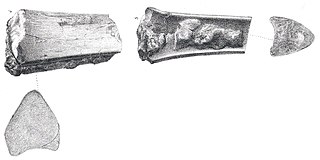
Ornithostoma is a genus of pterodactyloid pterosaur that lived during the Early Cretaceous period of Europe, around 110 million years ago. Ornithostoma was once thought to have been a senior synonym of the pteranodontid Pteranodon due to its toothless anatomy and prior naming.

Istiodactylus is a genus of pterosaur that lived during the Early Cretaceous period, about 120 million years ago. The first fossil was discovered on the English Isle of Wight in 1887, and in 1901 became the holotype specimen of a new species, O. latidens, in the genus Ornithodesmus. This species was moved to its own genus, Istiodactylus, in 2001; this name is Greek for "sail finger". More specimens were described in 1913, and Istiodactylus was the only pterosaur known from three-dimensionally preserved fossils for much of the 20th century. In 2006, a species from China, I. sinensis, was assigned to Istiodactylus, but it has also been suggested to belong to a different genus.
Paleontology or palaeontology is the study of prehistoric life forms on Earth through the examination of plant and animal fossils. This includes the study of body fossils, tracks (ichnites), burrows, cast-off parts, fossilised feces (coprolites), palynomorphs and chemical residues. Because humans have encountered fossils for millennia, paleontology has a long history both before and after becoming formalized as a science. This article records significant discoveries and events related to paleontology that occurred or were published in the year 1887.
The Cambridge Greensand is a geological unit in England whose strata are earliest Cenomanian in age. It lies above the erosive contact between the Gault Formation and the Chalk Group in the vicinity of Cambridgeshire, and technically forms the lowest member bed of the West Melbury Marly Chalk Formation. It is a remanié deposit, containing reworked fossils of late Albian age, including those of dinosaurs and pterosaurs.

Pteranodontoidea is an extinct clade of ornithocheiroid pterosaurs from the Early to Late Cretaceous of Asia, Africa, Europe, North America and South America. It was named by Alexander Wilhelm Armin Kellner in 1996. In 2003, Kellner defined the clade as a node-based taxon consisting of the last common ancestor of Anhanguera, Pteranodon and all its descendants. The clade Ornithocheiroidea is sometimes considered to be the senior synonym of Pteranodontoidea, however it depends on its definition. Brian Andres in his analyses, converts Ornithocheiroidea using the definition of Kellner (2003) to avoid this synonymy.
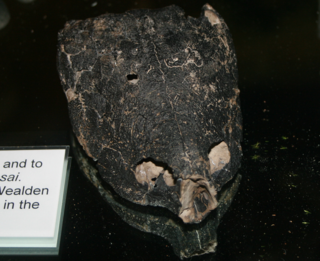
The Helochelydridae are an extinct family of stem-turtles known from fossils found in North America and Europe spanning the Early to Late Cretaceous.

Ornithocheiromorpha is a group of pterosaurs within the suborder Pterodactyloidea. Fossil remains of this group date back from the Early to Late Cretaceous periods, around 140 to 92.5 million years ago. Ornithocheiromorphs were discovered worldwide except Antarctica, though most genera were recovered in Europe, Asia and South America. They were the most diverse and successful pterosaurs during the Early Cretaceous, but throughout the Late Cretaceous they were replaced by pteranodontians and azhdarchoids. The Ornithocheiromorpha was defined in 2014 by Andres and colleagues, and they made Ornithocheiromorpha the most inclusive clade containing Ornithocheirus, but not Pteranodon.

Nicorhynchus is a genus of anhanguerid pterosaur from the Cretaceous period. It contains two species, the type species, N. capito, from the Cambridge Greensand of England, and N. fluviferox from the Kem Kem Group of Morocco. These species were previously assigned to Coloborhynchus.
















